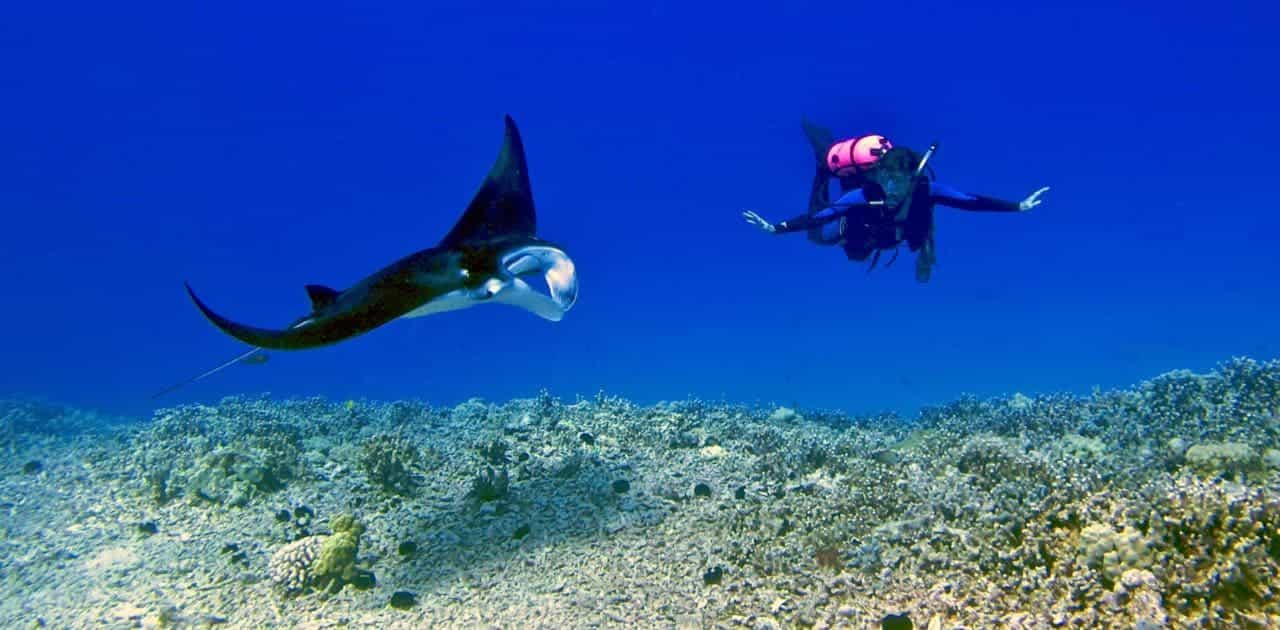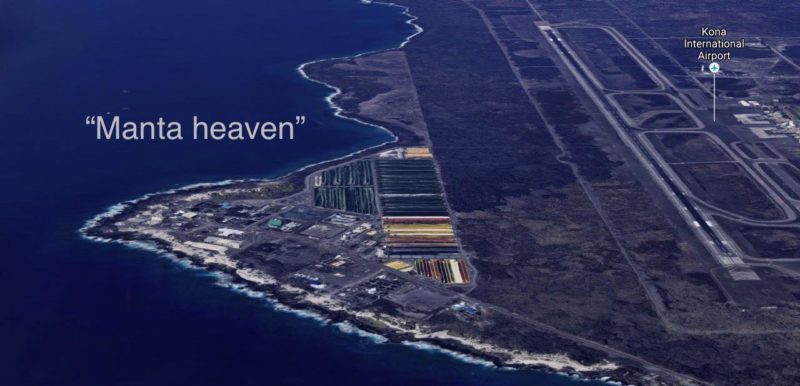The famous manta ray night dive in Kona is widely regarded as one of the most memorable dives on the planet. We agree with the experts and think that swimming with manta rays is one of the Big Island activities that you shouldn’t miss.
Table of contents
- Frequently Asked Questions about our Manta Rays
- Manta ray Tours
- Manta ray night snorkel
- Manta ray night dive
- What is it like to go on a manta ray snorkel/dive (with video)?
- What is the Manta ray dive/snorkel and why is it so special?
- About the Kona manta rays
- 3 good places where you can see manta rays
- Manta Ray encounter guidelines
Table of Contents
- Frequently Asked Questions about our Manta Rays
- Manta ray Tours
- Manta ray night snorkel
- Manta ray night dive
- What is it like to go on a manta ray snorkel/dive (with video)?
- What is the Manta ray dive/snorkel and why is it so special?
- About the Kona manta rays
- 3 good places where you can see manta rays
- Manta Ray encounter guidelines
This guide is structured as follows: first, we explain why we think that swimming with the manta rays is such a memorable experience. Then, we give you a complete overview of the different ways in which you can hop in and try it yourself.
Frequently Asked Questions about Manta Rays:
Because the Manta Ray snorkel is so popular we have written an extensive guide with all the ins and outs about it. To make your reading experience easier we have compiled the most frequently asked questions about manta ray below. Just click a question to get the answer!
Short answer: You most likely can re-book your tour.
Longer answer: It is impossible for manta ray tour operators to guarantee manta rays sightings every night of the year and it is possible that you’ll be unlucky and join a manta ray night dive/snorkel without seeing a single manta ray.
If this happens it is standard practice for the tour operators to either re-book you free of charge or to give a large discount for a tour one of the following nights. However, you should check these conditions yourself before booking.
This means that it is wise to plan your manta ray night dive early during your stay so that, if necessary, you can reschedule your tour without running into too many conflicts with the rest of your itinerary!
The Manta rays you see at the night dive are all locals! Mantas are not a migrating species and show up for dinner at their feeding grounds for their daily feeding. This means that any time of year is good for seeing them.
The biggest difference between the night dive and the night snorkel is your (vertical) location.
- If you go on a snorkeling tour you will stay near the water surface, probably holding on to a flotation device that also has lights attached to it to attract plankton and thus the manta rays.
- If you go on a diving tour you will be sitting on the ocean floor close and see the manta rays by looking up.
See this video to see the difference for yourself.
Please don’t touch Manta Rays!
Manta Rays are covered by a thin coating of protective mucous that protects them from bacterial infections. Removing part of it by touching the rays exposes the mantas to infection.
Absolutely!
While manta rays are related to stingrays they do not have a stinger (or a barb) and can’t hurt divers or swimmers. Mantas feed on plankton (microscopic sea organisms) and their only possible interest in humans comes out of curiosity.
While you can sometimes see manta rays “in the wild” during daytime it is very difficult to anticipate on that happening. The Big Island is unique in that it has three feeding locations where you can consistently see Manta Rays when they feed at night:
- Manta Village,
- Manta Heaven,
- Near the Kawaihae harbor.
The chance of seeing a manta ray during a tour at any of these locations in higher than 90%, read more about these locations on our website.
Get in touch with us for a personal answer if you have a question that is not answered above or in our guide.
Manta Ray Tours
Swimming with the Manta rays is possible both while snorkeling and while diving. We discuss both below:
- Manta ray night snorkel
- Manta ray night dive
- What is it like to go on a manta ray snorkel/dive (with video)?
Good to know: Manta ray diving and snorkeling tours are very popular and the good tours tend to get fully booked often days in advance. Book this activity early! If you want to see the manta rays without getting wet yourself you should visit the manta learning center.
The Manta Ray Night Snorkel
During the manta ray night snorkel you will spend your time in the water looking down while holding on to a flotation device. Bright lights are projected down into the water to attract plankton. The manta rays feed on this plankton and come very close to the water surface while feeding.
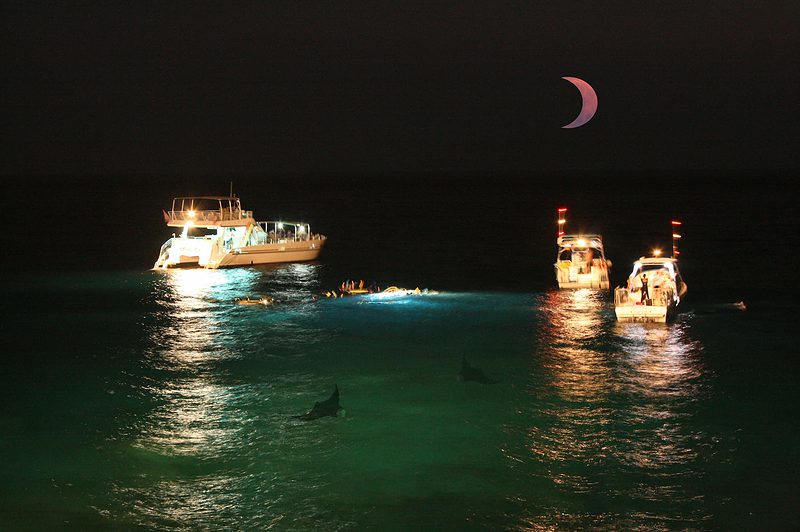
During most manta ray snorkels you will hold onto a floating raft to best see the manta rays. Image: Hawaii Tourism Authority (HTA) / Kirk Lee Aeder
There are many companies on the Kona coast that take you out at night on the manta ray night snorkel, but not all of them take the same amount of care when it comes to manta ray well-being. We always recommend the following tour, because they were once of the preferred members of the Manta Ray Green List when it was still around, and get consistently great reviews:
Manta Ray Snorkel Tour at Manta Village
Snorkel adventure from a 50-foot luxury catamaran to see the majestic manta rays at the world-famous "Manta Village" location in Keauhou (south Kona).
from:
$130
What is a suggested tour?Our suggested tours are hand-picked tours that receive consistent good reviews, give back to the community, and work hard to minimize their impact on the environment. Read more about these tours on our website.Good to know: it is not possible to snorkel freely around during the tours because your snorkel and fins could damage the protective skin coating of the manta rays.
Only for people that like a wild ride: small group manta ray snorkel from a zodiac
If getting at arms length from giant manta rays is not enough of a rush for you you could spice up the “getting there and back” part of your tour a bit. All other tours recommended in this guide use large and stable vessels that make sure that you get an uneventful ride to the manta ray location. Sometimes boring is good :).
The following tour however caters to people that are looking for a fast and bumpy ride. It uses a Navy style zodiac vessel for the ~10 minute boat ride from the harbor to the snorkel spot and holding onto the boat all those 10 minutes si not a bad idea. Interested?
Kona Manta Ray Night Snorkel on Navy Speed Boat
13 guests max Manta Ray night snorkel. Snorkel with Manta Rays at night while hanging on a light board - Snorkel gear & wet suit included.
Duration: 1 hour 20 minutes
By: Hawaii Island and Ocean Tours
Free cancellation: up to 72 hours before tour
from:
$99
What is a suggested tour?Our suggested tours are hand-picked tours that receive consistent good reviews, give back to the community, and work hard to minimize their impact on the environment. Read more about these tours on our website.Manta Ray Night Dive
You need to be a certified scuba diver to join the manta ray night dive. During the dive you will spend most of your time sitting on the ocean floor while the manta rays feed in the water above you. Manta rays can come as close as a nose-length during the night dive.
You can get an impression of how it is to go on a manta ray night dive from the following video. In it, you see Keller Laros (founder of the Manta Pacific Research Foundation) give a presentation on how to behave during the dive to a group of people about to go diving. The last few minutes show footage of that same manta ray dive.
There are several companies on the Kona coast offer this option (see below) but we prefer recommending the manta ray dive organized by Torpedo Tours because of their commitment to manta ray safety through their active membership of the Manta Ray Green List (the Green List was discontinued in 2023).
Manta Ray Night Snorkel & Dive
The famous manta ray night dive/snorkel in Kona is one of the most memorable dives around the planet. 100% Hawaiian Bucket List!
from:
$129
What is a suggested tour?Our suggested tours are hand-picked tours that receive consistent good reviews, give back to the community, and work hard to minimize their impact on the environment. Read more about these tours on our website.What is it like to go on a manta ray night dive/snorkel tour?
Manta ray tours normally start at the harbor from which the boat departs. This boat will take you to one of the manta ray feeding zones. Before boarding or during your trip to the feeding grounds, the crew will teach you how to behave while in the water and teach you a thing or two about the manta rays.
Once you arrive at the tour location you will enter the water and wait for the manta rays show up. Count on being in the water for about 30 minutes. When the mantas are gone you will return to the harbor. The trip back can be cold so try bringing a comfortable windbreaker or sweater to keep you warm.
And what is the difference between the two? (video)
The difference between the manta ray snorkel and the manta ray dive is where you are during the tour. This is illustrated in the following video, which was filmed during a manta ray night dive in Kona.
In the video you see the divers sitting on the ocean floor looking up while the manta rays are swirling around to eat the plankton. On the water surface you can see stagnant and floating lights on the surface.
What is the Manta ray dive/snorkel and why is it so special?
During the Manta Ray dive (or snorkel) you will get to see these immense fish up close and personal. the manta rays are attracted by plankton, which in turn is attracted by bright lights. To catch the plankton the manta rays filter it out of the ocean by swooping through the water with their mouths open in something that we can only describe as a dance. The manta rays gracefully swim, turn, and somersault through the light beams, sometimes almost touching their spectators.
Perhaps the best way to express how special an experience the manta ray night dive is by quoting a certified and seasoned dive instructor:
Diving with mantas is one of the most satisfying things a person can do in the water. It’s impossible to describe the feeling of watching a massive fish the shape of a stealth bomber coming into vision. It’s akin to watching your child ride a bike for the first time or finding a winning lottery ticket. In fact, I often use the phrase ‘like watching a manta ray swim by’ as a way to describe the feeling of something awesome. Samuel Beckett – Planet Dive.
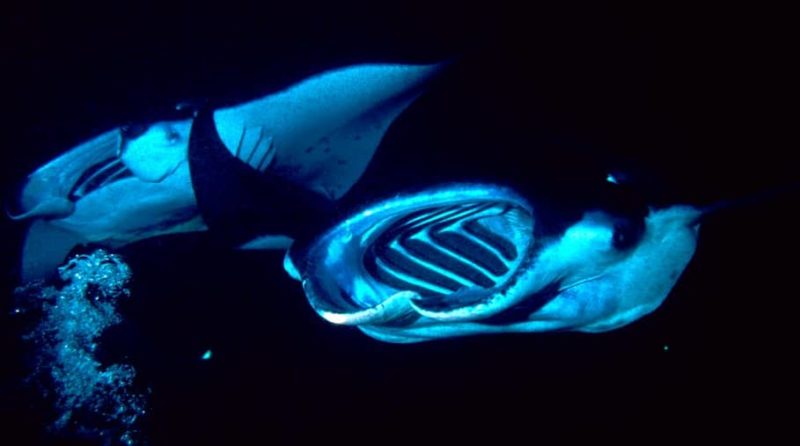
Two Manta Rays Feeding At Night off Kona, Hawaii. Image credit: wikipedia.
Why is the Kona dive so special?
Hawai’i is not the only place where you can swim with manta rays. Other popular places where you can have an encounter with these gentle giants are, for example, the Maldives, the Great Barrier Reef, and the Galapagos islands, but there is a distinction. Most manta ray dives at these other locations happen at so-called “cleaning stations”. These cleaning stations are places where the manta rays go to get their skin cleaned by smaller creatures (more information).
Being creatures of habit Manta Rays also have specific places where they to go to eat: feeding stations. There are three such know stations know off the Kona coast: Manta Village, Manta Heaven, and an unnamed location off the Kohala coast. The Hawaiian manta rays first started coming to the feeding stations to feast on all the plankton attracted by bright hotel lights shining on the water.
Nowadays tour operators bring bright light with them to attract plankton and to give their guests front row seats for ‘dinner’. Divers carry a light and shine it up towards the surface, while snorkelers typically hold on to a float with a light that shines down.
Seeing mantas feed is far more spectacular than seeing them get groomed, and this is why Hawaii is such a good place to see manta rays.
The Kona Manta Rays
The manta rays that inhabit Hawaiian waters belong to the Mobula alfredi species. These so-called reef manta rays are the second largest species of manta rays in the world, and can grow up to a wingspan of 18 ft (5.5m)! On average, the manta rays you can see around Kona will be about 12 ft.
Manta rays eat plankton, which they filter out of the water by swimming with their (giant) mouths open. The reef manta rays in Hawaii do not migrate and spend their lives in the coastal waters around the islands. Manta rays can live to be 50 years old, and all of the specimens in the waters off Kona have been given their own name.
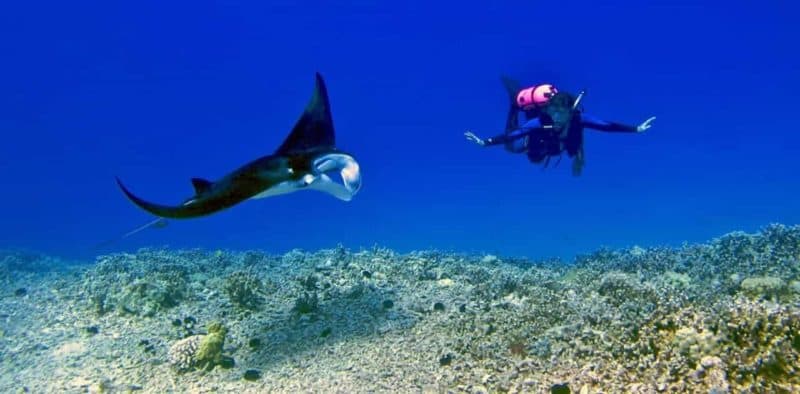
A female scuba diver swims with a young male Manta ray in the Kona district / Big Island. By Steve Dunleavy from Lake Tahoe, NV, United States – Nick and Isabelle, Kona Hawaii, CC BY 2.0, Link
The 3 best location to see manta rays on the Big Island
The two most consistent and popular places to see manta rays at night are nicknamed “Manta Village” and “Manta Heaven”. A third, less reliable but also less crowded location, is off the Waikoloa coast near the Kohala Coast Resorts. These 3 locations are discussed below:
Manta Village (south of Kona)
This is the original manta ray night dive location. Manta Village is located off the coast from of the Sheraton Keauhou Bay Resort & Spa in Keauhou, about 7 miles south of Kona.
It is the location with the highest success rate in manta ray sightings. In 2013, for example, a staggering 96% of all manta ray tours reported seeing manta rays, with an average of 4 manta rays per night (source).
There are a few local operators (such as Sea Paradise) that operate from the nearby Keauhou Bay to reach this site. This cuts down travel time down from 45+ minutes to only a few, which is great for those of you prone to sea sickness, and also means you will be exposed to the elements for a much shorter time after being submerged in the ocean for 45 min to an hour (it can get cold at night on the ocean).
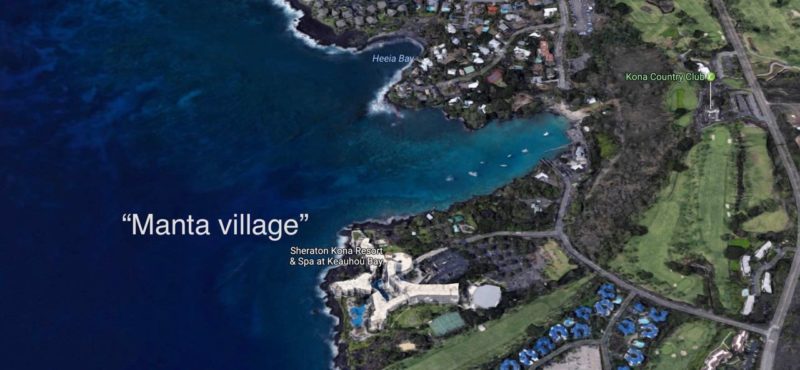
Manta village is located offshore of the Sheraton Kona resort at Keauhou Bay. Image credit: google maps.
The Manta Learning Center in the Sheraton Kona resort
Fronting the Manta Village location is the Sheraton Kona resort in which you can find the manta learning center. This is a 700 square ft space where you can see beautiful manta ray photos, as well as general information about manta ray anatomy, life cycle and feeding, reproductive and behavioral patterns. There is also a 15-minute video display showing footage shot during night dives, and every day at 6 pm you can listen to a presentation about manta rays.
Manta learning center website.
Manta Heaven (north of Kona)
This site is located offshore of the Kona International Airport, about 8 miles north of Kona. Manta Heaven is a very popular spot for daylight dives, and is also known as “Garden Eel Cove”.
Of course, this spot is also known for manta ray night dives. The success rate at Manta Heaven is a bit lower than that at the Manta Village location, with 90%, is still very high. The big selling point for this location is the number of manta rays you can see. The average number of manta rays seen here per night in 2013 was 11, compared to ‘only’ 4 at Manta Village.
One recommended operator that uses this dive site is Torpedo Tours.
Kohala Coast (near Waikoloa)
This is the most northern location on the Big Island to see the manta rays. It is located close to Waikoloa Village and the Kohala Resorts, near Kawaihae Harbor.
The main selling point for this manta ray night dive spot is the lack of other tourists. At the other two locations, you can find yourself in the water with 50 to 100 other people at a time! That will never happen here, and sometimes the group that you are with is the only one in the water. The reason for this is also the main disadvantage of this location: there are fewer manta rays and they are seen here less frequently.
Guidelines for manta ray encounters and the Manta Green List
Tour operators in Hawaiʻi operate under strict and self-enforced standards. Up to 2023 Hawai’i Ocean Watch maintained a rather small “Green List” with tour operators that followed these standards and all tour operators we recommend on this page were part of that (now discontinued) list.
Responsible guidelines for the Manta Ray Night Dive/Snorkel:
While manta rays in Hawaiian waters are protected by law from being hunted, the increasing popularity of manta ray dives and the associated crowding of their feeding zones puts them in a vulnerable position. Because of this the Ocean Recreation Council of Hawaii and PADI’s Project AWARE (Aquatic World Awareness, Responsibility, and Education) drafted the following guidelines to be followed by all participants of the Kona Manta Ray Night Dive/Snorkel:
- Observe only: No touching. Resist the urge to “pet” the mantas. This will rub off their protective mucus coating. Do not chase, grab, or try to take a ride on the mantas. This doesn’t benefit the animal in anyway.
- Diver position: Divers, please stay on or near the sand, rubble or boulder bottom. An open water column is necessary for the mantas to maneuver. Avoid contact with coral, sea urchins, or other marine life. Form a semi-circle with your group.
- Snorkeler position: Snorkelers, please stay on the surface. Do not dive down into the water column where the mantas are feeding.
- Use of lights: Divers, please shine lights up into the water column to attract plankton. Snorkelers, please shine lights down.
- Making bubbles: Divers, please avoid exhaling bubbles directly into the mantas’ faces.
- Taking photos or videos: Be considerate of people and mantas when taking underwater photos or video. Minimize your equipment in the water column and let the mantas come to you.
1. We are part of the hawaiiactivities affiliate program. Read more about our participation. ↩
